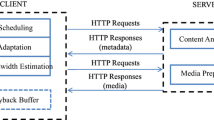Abstract
The transmission of stored video across an ATM network is considered for interactive applications with bounded reaction times. The performance of the services renegotiated VBR (RVBR) and renegotiated CBR (RCBR) is investigated for this class of applications by trace-driven simulations. The goal is to determine the most efficient service for interactive applications. Here we present three basic results. First, for delay sensitive applications smoothing the video stream in advance is much more efficient than adding smoothing buffers to the network switches. Second, services with renegotiation (RCBR, RVBR) are better suited for interactive applications than the static services CBR and VBR. Third, the RVBR service with a deterministic call admission control scheme is the best choice for interactive applications that require small reaction times.
Similar content being viewed by others
References
S. Chong, S. Li and J. Ghosh, Predictive dynamic bandwidth allocation for efficient transport of real time VBR video over ATM, IEEE Journal on Selected Areas in Communications 13(1) (January 1995).
R.L. Cruz, A calculus for network delay, part I and II, IEEE Transactions on Information Theory 37(1) (January 1991).
R.L. Cruz, Quality of service guarantees in virtual circuit switched networks, IEEE Journal on Selected Areas in Communications 13(6) (August 1995).
Digital audio-visual council, DAVIC 1.2 specification part 1. Description of DAVIC functionalities (1996).
M.W. Garret and W. Willinger, Analysis modelling and generation of self similar VBR video traffic, in: Proceedings ACM Sigcomm, London (September 1994).
M. Graf, Traffic shaping for VBR video, in: Proceeding 4th Open Workshop on High Speed Networks, Telecom Bretagne, Brest, France (1994).
M. Grossglauser, S. Keshav and D. Tse, RCBR-a simple and efficient service for multiple timescale traffic, ACM Sigcomm 95 (August 1995).
R. Guerin, Equivalent capacity and its application to bandwidth allocation in high-speed networks, IEEE Journal on Selected Areas in Communications 9(7) (September 1991).
R. Guerin and L. Guen, A unified approach to bandwidth allocation and access control in fast packet-switched networks, INFOCOM '92.
S. Gumbrich, H. Emgrunt and T. Braun, Dynamic bandwidth allocation for stored VBR video in ATMendsystems, in: Proceeding 7th IFIP Conference on High Performance Networking (HPN '97), White Plains, NY (May 1997).
S. Gumbrich and J. Sandvoss, Comparison of media scaling techniques for real time packet video transport, IEEE HPCS, Mystic Conneticut (August 1995).
D. Hehmann, M. Salmony and H. Stuettgen, Transport services for multimedia applications, IFIP WG6.1/WG6.4, in: Proceeding Workhop on Protocols for High Speed Networks(North Holland, 1989).
F. Kelly, Effective bandwidth at multiclass queues, Queueing Systems 9 (1991).
E. Knightly, D. Wrege, J. Liebeherr and H. Zhang, Fundamental limits and tradeoffs of providing deterministic guarantees to VBR video traffic, ACM Sigmetrics '95, Otawa, Canada (May 1995).
E. Knightly and H. Zhang, A new approach to support delay-sensitive VBR video in packet-switched networks, NOSSDAV 1995, Durham, New Hampshire (18–21 April 1995).
E. Knightly and H. Zhang, Connection admission control for RED-VBR, a renegotiation-based service, IFIP IWQoS '96, Paris, France (1996).
K. Lakshman and R. Yavatkar, An empirical evaluation of adaptive QoS renegotiation in an ATM network, NOSSDAV 1996, Zushi, Japan (1996).
S. Liew and C. Tse, Video aggregation: adapting video traffic for transport over broadband networks by integrating data compression and statistical multiplexing, IEEE JSAC 14(6) (August 1996).
J. McManus and K. Ross, Video on demand over ATM: constant-rate transmission and transport, IEEE JSAC 14 (August 1996).
R. Onvural, ATM Networks: Performance Issues (Artech House, 1994).
C. Raffaelli, F. Callegati and M. Casoni, Evaluation of call blocking in a multiuser ATM environment based on definitions of equivalent capacity, EFOC & N, Brighton (June 1995).
D. Reininger, G. Ramamurthy and D. Raychaudhuri, VBR MPEG video coding with dynamic bandwith renegotiation, in: Proceedings IEEE International Conference on Communications 1995, NJ, USA (1995) pp. 1773–1777.
J. Salehi, Z. Zhang, J. Kurose and D. Towsley, Supporting stored video: reducing rate variability and end to end resource requirements through optimal smoothing, ACM Sigmetrics (May 1996).
ATM UNI signalling specification version 4.0., ATM Forum/95–1434 (April 1996).
ATM Forum traffic managment specification version 4.0., ATM Forum/95–0013 (February 1996).
ATM user-network interface (UNI) specification version 3.1., ATM Forum (1995).
F. Vakil, A capacity allocation rule for ATM networks, IEEE Globecom (1993).
D. Wrege and J. Liebherr, Video traffic characterization for multimedia networks with deterministic service, IEEE INFOCOM (1996).
H. Zhang and D. Ferrari, Rate controlled static priority queuing, IEEE INFOCOM (1993).
H. Zhang and D. Ferrari, Improving utilization for deterministic service in multimedia communication, in: Proceedings International Conference on Multimedia Computing and Systems, Boston, MA (May 1994).
Z. Zhang, J. Kurose, J. Salehi and D. Towsley, Smoothing, statistical multiplexing and call admission control for stored video, IEEE JSAC Special Issue on Real-Time Video Services in Multimedia Networks (to appear).
ITU-T Recommendation I.371. Traffic control and congestion control in B-ISDN (August 1996).
ITU-T Recommendation Q.2963.1. Peak cell rate modification by the connection owner (July 1996).
ITU-T Recommendation Q.2963.2. Connection modification-modification procedures for sustainable cell rate parameters (September 1997).
Author information
Authors and Affiliations
Rights and permissions
About this article
Cite this article
Gumbrich, S. Dynamic bandwidth allocation for interactive applications. Telecommunication Systems 11, 31–46 (1999). https://doi.org/10.1023/A:1019128814087
Issue Date:
DOI: https://doi.org/10.1023/A:1019128814087




